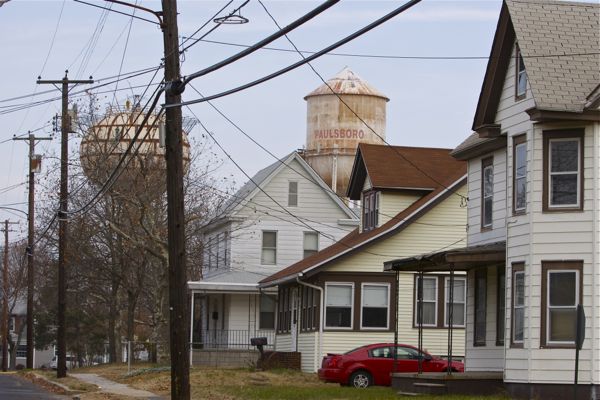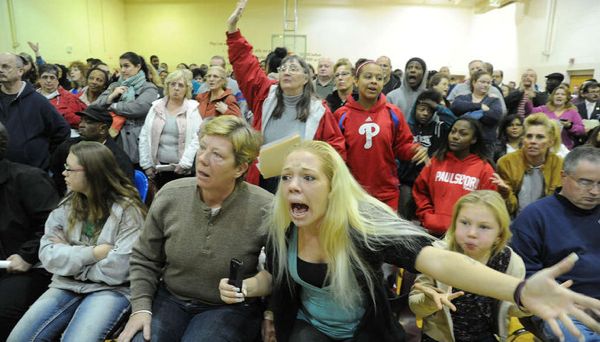“a noticeable absence of birds in the sky”
[Updates below]
Perhaps unwittingly, Reuters, via the New York Times struck a chord in their story on the Toxic Train Wreck:
Skeptical residents shouted doubts about the assurances they heard from officials that vinyl chloride levels were low, complaining that their neighborhood now smelled like dry-cleaning chemicals and that there was a noticeable absence of birds in the sky.
This year marked the 50th anniversary of Rachel Carson’s earth shattering book “Silent Spring“.
The book documented the toxic effects of chemicals and pesticides, particularly on birds, and exposed the lies of the chemical industry and the culpable failures of government to properly regulate to protect people and ecosystems.
The book evoked the nightmarish possibility of a world without birds, thus the title.
So, half a century later – thirty years after the “Reagan Revolution” (“government is the problem”) – we can actually say we’ve come full circle in Paulsboro NJ.
“A noticeable absence of birds” is now on the table.
BTW, Larry Rangonese of DEP is a god damned liar (again I have to call him out on that). He said this:
Respiratory problems, coughing and light-headedness were the problems that residents exposed to the hazardous chemicals may experience, “but there is no long-term effect,” said Lawrence Ragonese, spokesman for the state Department of Environmental Protection.
“We are being very conservative because we are worried about your health,” he said.
Larry must know that vinyl chloride is a known human carcinogen.
Larry must know that there is no threshold below which exposure to a known carcinogen is “safe”.
Larry must know that any long term health effects are not known and unknowable.
Larry must know that there is no data and no scientific basis to state – unequivocally – that “there is no long-term effect.”
Ignoring this science is not being “very conservative” and taking a precautionary approach to public health.
Stop lying Larry, please.
At least Dr. Landrigan from Rutgers downplayed the risk with a valid statement – in a Wall Street Journal article he called the long term risks “vanishingly low” – While I disagree with that judgement, it is scientifically valid.
[End Note: and isn’t it amazing how wisdom emerges from the community? Bottom up.
Paulsboro is a working class town and I doubt there are trained toxicologists and professional risk communicators, yet they knew they were being lied to.
And I also doubt there were any ecotoxicologists, but the community knew damn well that their ecosystem was being poisoned.
And there probably were no air quality modelers to interpret the data and get fooled by the fact that vinyl chloride is an odorless gas. No, the people who live there simply trusted their far more sensitive and accurate noses and detected the odors of the toxic chemical soup in the air of the town, put there by the “chemical industrial complex” that surrounds them.
They have eyes too and can see and smell that chemical industrial complex, and know damn well that they are being poisoned by far more than a train accident and are being exposed – on a daily basis – to far more than that one chemical, vinyl chloride, coming from one wrecked train car.
And few if any lawyers in town who know about the regulatory framework for chemical risk management – from prevention through community emergency planning and response – and how badly DEP was doing their job on that.
But on the other hand, DEP knows all this too –
So their narrow framing of and response to the issue (e.g. risks from a single train accident, a single chemical, and only acute health effects, no regulatory role, etc.) compounds and greatly magnifies their lies.
[Update #1 – the Philadelphia Inquirer story on last night’s “raucus” meeting published this amazing photo: (more below)
The story included this quote:
“Who’s the genius who set the perimeter?” asked Nakia Pratt, 36, who lives in Woodbury but whose family lives in Paulsboro.
There is validity in that comment. I was there on Tuesday morning and spoke with people and we all noticed that the evacuation zone was east of the incident, while the wind sock showed the wind blowing from east to west. Thus, the western side should have been evacuated as well.
[Update #2 – The South Jersey Times story nailed the bird, risk communication, and trust issues perfectly:
As Larry Ragonese, a spokesman for the DEP, attempted to give an update of vinyl chloride levels in the air and monitoring efforts being taken — and his microphone continuously shorted out — boos and shouts of “it’s a lie!” and “tell us the truth!” from the crowd overrode his voice.
“Everybody keeps circle talking,” Steve Filiaggi said.
“It’s worse than what he’s saying,” yelled Tony Bennett, who was evacuated from his Buck Street home. “Go home tomorrow morning and listen for a bird to chirp. You won’t hear it!”
“If the birds are gone, the people should be gone,” he added afterward.
[Update #3 – the people in Paulsboro might want to consider this in evaluating various claims about chemicals, and vinyl chloride in particular:
Vinyl Chloride: A Case Study of Data Suppression and Misrepresentation
Abstract
When the U.S. Environmental Protection Agency (EPA) finalized its 2000 update of the toxicological effects of vinyl chloride (VC), it was concerned with two issues: the classification of VC as a carcinogen and the numerical estimate of its potency. In this commentary we describe how the U.S. EPA review of VC toxicology, which was drafted with substantial input from the chemical industry, weakened safeguards on both points. First, the assessment downplays risks from all cancer sites other than the liver. Second, the estimate of cancer potency was reduced 10-fold from values previously used for environmental decision making, a finding that reduces the cost and extent of pollution reduction and cleanup measures. We suggest that this assessment reflects discredited scientific practices and recommend that the U.S. EPA reverse its trend toward ever-increasing collaborations with the regulated industries when generating scientific reviews and risk assessments.

